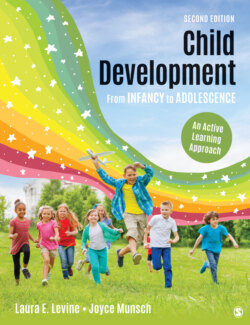Читать книгу Child Development From Infancy to Adolescence - Laura E. Levine - Страница 202
На сайте Литреса книга снята с продажи.
How Genes Shape the Environment
ОглавлениеSo far, we have described the way genes affect physical and biological processes and the way the environment influences the expression of genes to produce various developmental outcomes. In a third developmental mechanism, genes influence the nature of the environment in which they exist.
Sandra Scarr (1992) proposed that one way to think about how genes shape the environment is to see them as passive, active, or evocative. With a passive gene-environment interaction, the genes don’t have to do much to be expressed, as when children are born into a family that provides them with both their genes and an environment that encourages the expression of those genes. For example, singer Bruno Mars probably inherited genes associated with musicality from his father who was a Latin percussionist and his mother who was a singer. However, his training in music that began at age 4 when he did an Elvis impersonation as part of his family’s Las Vegas-style review show also provided an environment that supported his talent as he grew up. He has gone on to a highly successful career in music.
Passive gene-environment interaction: When a child’s family shares his own genetically determined abilities and interests.
Following in the family footsteps. Bruno Mars began performing as “Little Elvis” in his family’s musical act at the age of 4. As an adult, he has gone on to sell over 11 million albums worldwide and was named entertainer of the year at the 2017 American Music Awards. He likely received both genes and environmental influences that set him on his path to a successful singing career.
Catherine McGann / Contributor via Getty Images
Kevork Djansezian/ Getty Images
An active gene-environment interaction occurs when genes become a driving force for children to seek out experiences that fit their genetic endowments (Jaffee & Price, 2008). A child with genes that promote risk-taking may be drawn like a magnet to snowboarding, bungee jumping, or whatever is offered that provides a physical and risky challenge. On the other hand, a child with a genetic predisposition to be timid will seek out activities that are solitary and not overly stimulating or exciting. As we described in Chapter 1, this type of gene effect is also called niche-picking or niche-building. You find the part of your environment (the niche) in which you feel most comfortable, and you actively make this choice (Feinberg, Reiss, Neiderhiser, & Hetherington, 2005).
Active gene-environment interaction: When children’s genetic endowment becomes a driving force to seek out experiences that fit their genetic endowments.
Finally, with evocative gene-environment interaction, genes cause children to act in a way that draws out or “evokes” certain responses from those around them. For example, individuals with certain forms of a gene related to the production of the hormone oxytocin were more outgoing and less shy compared to individuals with a different form of the same gene. Researchers found that the more friendly behavior exhibited by these individuals evoked a positive response from people in their social world, resulting in a higher level of social support and more friends (Creswell et al., 2015).
Evocative gene-environment interaction: When children’s genetic endowment causes them to act in a way that draws out or “evokes” certain responses from those around them.
It is important to realize that all genes may operate in all three of these ways. A child who has inherited genes for musicality and has a musical family may also actively seek out musical experiences outside of the family and this behavior evokes certain responses from people such as music teachers who further promote the child’s musical interests and abilities. Our genes play out their influence in our environment, but they also have an important role in creating our environment.
